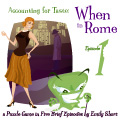When in Rome 1: Accounting for Taste — 2 of 31
Emily Short
Part 1 - World Model
Chapter 1 - Some Characteristics and Adjectives
Section 1 - Physical truths
A thing can be stinky or inoffensive. [Stinky things will offend animals with strong normal senses of smell, but attract those from sulfurous or methane-heavy atmospheres.]
A thing can be explored or unexplored. A thing is usually unexplored. [Explored means that the creature has already interacted with it once; it is no longer as interesting for creatures to play with.]
A thing can be useful or pointless. A thing is usually useful. [Pointless means that the creature has tried to lift or eat the object and found it intractable; it will not try again.]
Toughness is a kind of value. A thing has toughness. The toughnesses are sturdy, leathery, and papery. A thing is usually sturdy. [Toughness indicates the susceptibility of a thing to being eaten or destroyed by a creature.]
Weight is a kind of value. The weights are light, medium-weight, or heavy. A thing has weight. A thing is usually light. [Weight indicates whether creatures of different strengths will be able to pick something up.]
An electric light is a kind of device. Carry out switching on an electric light: now the noun is lit. Carry out switching off an electric light: now the noun is unlit. Carry out someone trying switching on an electric light: now the noun is lit. Carry out someone trying switching off an electric light: now the noun is unlit.
Understand "shine [electric light]" as switching on. Instead of burning an electric light, try switching on the noun.
Understand "point [something] at [something]" or "shine [something] at [something]" or "turn [something] toward/towards/at [something]" as orienting it toward. Orienting it toward is an action applying to two things. Carry out orienting something toward something: say "It's hard to see what good that would do.". Instead of orienting an electric light toward the creature: try turning the noun.
